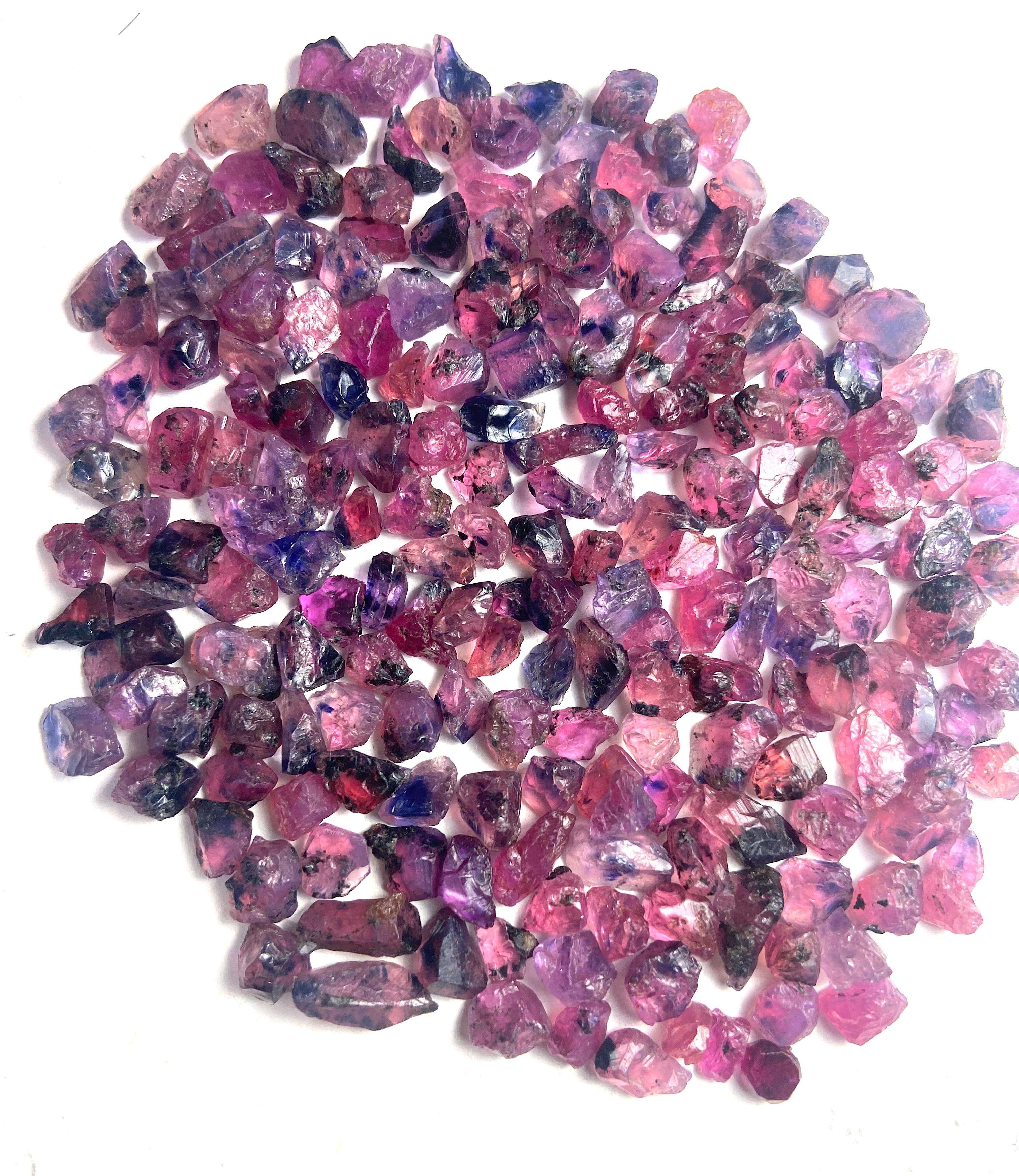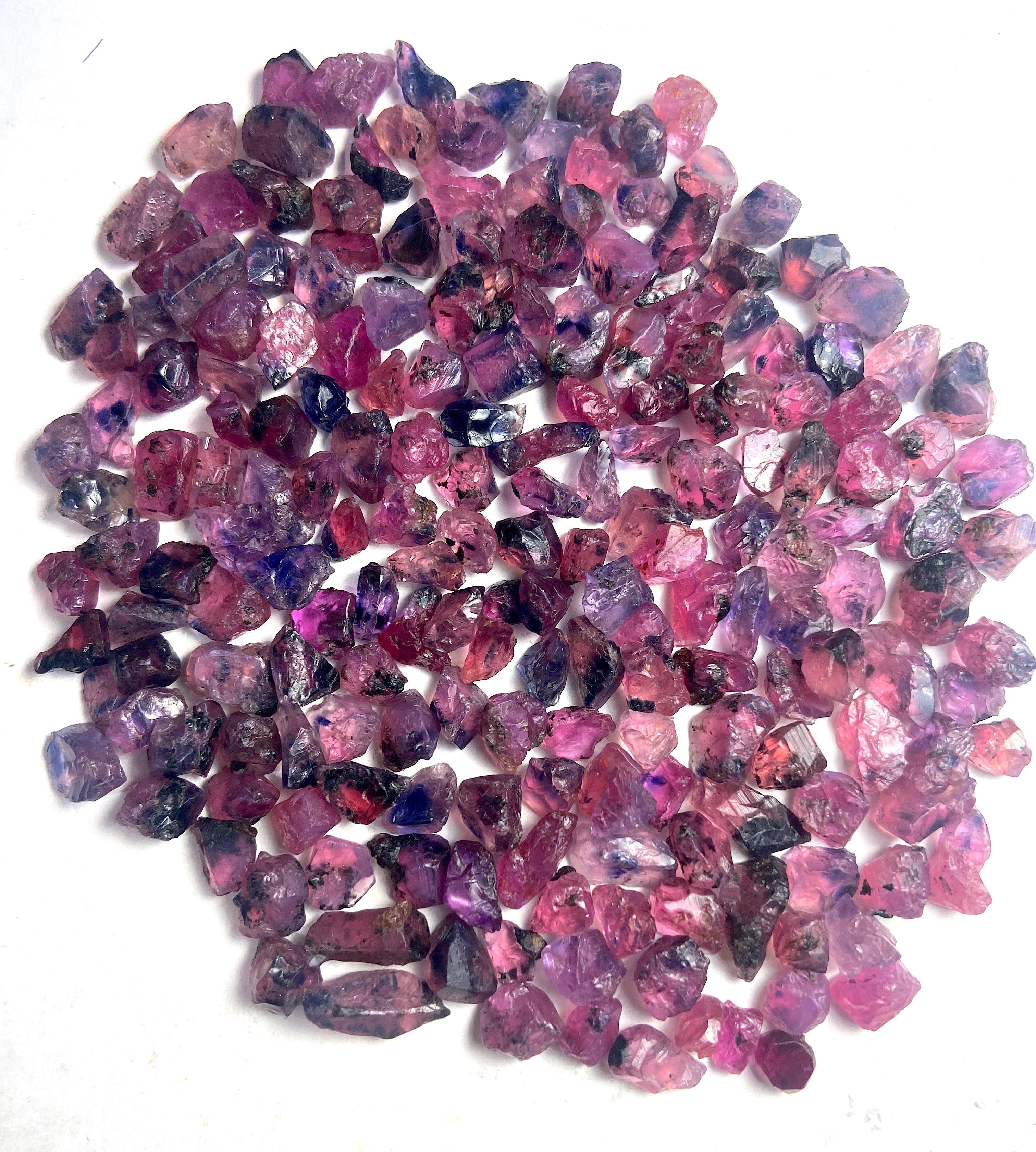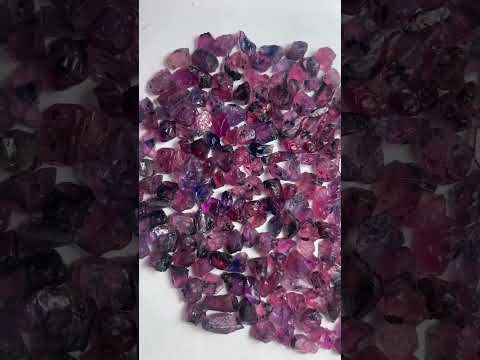
- Brand: Folkmarketgems
- SKU: spinel-23
- Product type: Faceting Rough
Gemstone Specification
| Specification | Details |
|---|---|
| Stone Name | Sapphires and Corundum |
| Shapes/Cut | Rough |
| Carat Weight | under carat to 1 carats |
| Color | Purple, Purplish Pink, Blue, and Dark Blue |
| Clarity | Eye Clean, Transparent, VS, and VVS |
| Origin | Tanzania |
| Treatments | No |
| Birthstones | September |
| Deal Type | Small Bulk Lots / Start Up Deals |
Product Description
Grab Small to Medium Deals of Natural Rough Bluish Sapphires
These rough winza sapphires are unique due to duel color of blue and purple. Wiza sapphires looks beautiful after faceting or cabbing and gives unique hue and color. Available in 50 to 150-carat parcels
Key Product Features
- Stone Name: Natural Rough Sapphires
- Types: Natural
- Weight: Total parcel weight – 50 to 150 carats
- Size Range: .50 cent up to 1.80 ct per piece (approximate)
- Color Range: purplish-pink, fuchsia, and magenta hues.
- Transparency: Moderate to good transparency, Included, Si, VS
- Treatment: Unheated
- Origin: Winza region, Tanzania – famous for vibrant, high-quality corundum.
- Hardness: 9 on Mohs Scale
Technical Analysis of Winza Sapphires
Visual Analysis of Your Rough Sapphire Parcel:
- Color Characteristics: Distinctive blue-purple pleochroism with color zoning ranging from deep violet-blue to pinkish-purple . Inclusions of deep indigo to bluish-black zoning, indicating natural corundum growth
- Crystal Habbits:
- Hexagonal prismatic crystals with typical corundum morphology, showing both tabular and elongated forms
- Mixture of tabular, hexagonal, and irregular shapes.
- Several crystals show good termination and could yield symmetrical stones.
- Transparency Range: Semi-transparent to translucent with some opaque sections containing inclusions
- Surface Features: Natural crystal faces visible with some etching and weathering patterns typical of alluvial deposits
- Size Distribution: Mixed parcel showing stones from approximately 0.5ct to 1.8ct individual pieces
- Inclusion Patterns: Visible rutile silk, color zoning, and natural fractures characteristic of Winza material
Technical Specifications:
- Mineral Composition: Aluminum oxide (Al₂O₃) with trace chromium and iron causing color
- Crystal System: Trigonal (hexagonal appearance)
- Hardness: 9 on Mohs scale
- Specific Gravity: 3.95-4.03
- Refractive Index: 1.762-1.770 (birefringent)
- Pleochroism: Strong - violet-blue to purple-pink
- Origin Locality: Winza, Mpwapwa District, Tanzania
- Formation: Metamorphic origin in marble deposits
Cutting Potential Assessment:
- Faceting Yield: Approximately 35-45% weight retention expected
- Optimal Cuts: Oval, cushion, and emerald cuts to maximize color display
- Cabochon Suitability: Excellent for star stones if silk inclusions are present
- Color Enhancement: Heat treatment potential to improve clarity and color saturation
FAQs for Gemstone Cutters - Sapphires
Pre-Cutting Evaluation
Q: How do I assess the cutting potential of rough Winza sapphires? A: Examine under strong light for color zoning, check transparency with a penlight, and look for natural crystal faces that indicate orientation. Winza material often shows strong pleochroism, so orient the stone to maximize the best color.
Opinion: Winza material can be tricky due to uneven color distribution, so patience in examination is key. I recommend using a daylight-equivalent LED to judge true color.
Q: What's the expected yield when cutting Winza sapphires? A: Typically 35-50% weight retention, depending on inclusion patterns and desired final shape. The strong color zoning may require sacrificing weight to achieve even color distribution.
Opinion: If the rough has heavy inclusions, consider a lower-yield design (e.g., a concave cut) to maximize brilliance over carat weight. Winza’s unique color makes it worth the trade-off.
Q: Should I heat treat Winza sapphires before cutting? A: Many cutters prefer to cut first, then heat treat if needed. Winza sapphires often improve with gentle heating (1000-1200°C) to reduce silk and enhance color saturation.
Cutting Techniques
Q: What's the best orientation for cutting Winza sapphires? A: Orient the table perpendicular to the c-axis to minimize pleochroism and achieve the most attractive face-up color. The blue-purple zones should be positioned to create an even color blend.
Q: Which cutting wheels work best for sapphire? A: Start with 220-grit diamond for shaping, progress through 600, 1200, 3000, and finish with 8000-grit or higher. Ceramic wheels work well for final polishing.
Q: How do I handle the strong pleochroism in Winza sapphires? A: Use a dichroscope during orientation to identify the best viewing direction. Position the stone so the most attractive color combination is visible face-up.
Opinion: I prefer orienting Winzas to showcase their reddish-pink tones, as these are rarer and more marketable. However, some cutters prioritize blue for a cooler look—personal preference matters!
Common Challenges
Q: Why do my Winza sapphires chip during cutting? A: Check for internal stress fractures and natural parting planes. Use lighter pressure and ensure your lap is running true. Winza material can be brittle due to inclusion patterns.
Q: How do I deal with color zoning in the rough? A: Plan your cut to either embrace the zoning as a feature or position it to minimize visibility. Sometimes a slightly smaller stone with even color is preferable to a larger zoned stone.
Q: What causes the milky appearance in some areas? A: Fine rutile silk inclusions create this effect. Gentle heat treatment can often dissolve these inclusions, but test on a small piece first.
Finishing and Polish
Q: What's the best polish for Winza sapphires? A: Diamond compound on a tin lap gives excellent results. Cerium oxide on felt also works well for the final polish. Maintain consistent pressure and speed.
Q: How do I achieve that perfect mirror finish? A: Ensure each grit stage is complete before moving to the next. Clean the stone thoroughly between stages. Use a quality diamond compound and maintain your laps properly.
Q: Why do some facets appear duller than others? A: This often indicates incomplete polishing at previous stages or contamination between grits. Re-polish with the previous grit stage and ensure thorough cleaning.
Value Optimization
Q: What cuts maximize value for Winza sapphires? A: Oval and cushion cuts typically yield the best color and minimize waste. Round brilliants can be stunning but have lower yield. Consider the rough's natural shape when planning.
Q: When should I consider cabochon cutting instead of faceting? A: If the material shows strong silk that might create asterism, or if transparency is too low for effective faceting. Winza sapphires can produce beautiful star stones.
Q: How do I price my finished Winza sapphires? A: Consider color saturation, clarity, cut quality, and carat weight. Winza sapphires with good color and clarity can command premium prices due to their unique origin and distinctive color.
This analysis should help you maximize the potential of your beautiful Winza sapphire rough material!
Cutting Tips for Lapidary Artists
-
Orientation is Key:
Position the table perpendicular to the color zoning to maximize color play and avoid “dead” areas. -
Use Gentle Preforming:
Use a fine lap to preform – these crystals have natural fractures that may split under aggressive shaping. -
Deal with Zoning Smartly:
Some stones have visible color zoning or black rutile/silk inclusions. Consider brilliant cuts to mask zoning or use cabochon finish for opaque or heavily included stones. -
Heat Potential:
If clarity improvement is desired, these sapphires may respond well to heat treatment. Always test a sample before applying to the full lot. -
Polishing Suggestion:
Use diamond paste (50k–100k grit) on tin or Lucite laps for excellent luster.


